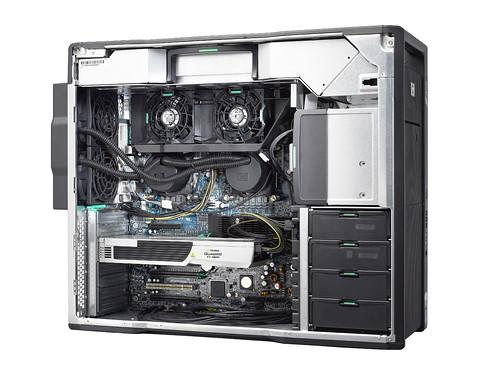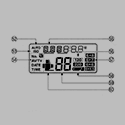|
Some more random data points: 2x Opteron 4386 + HD7950: 13s single Opteron 4386 + HD7950: 19s Throwing it through CodeXL again, it looks like the app changes the amount of data that's transferred for each set of kernel calls. On this Tahiti card it's a 1.1MB write, the work, then a 17KB read. Still, I believe I was right: the transfer time doesn't change a lot (~700microseconds on 6970, ~610us on 7950), though the GPU work itself is much faster (2050us on 6970 vs 360us on 7950). As you make your GPU bigger, you will likely eventually run into an Amdahl bottleneck on the data transfer. I would need more data points to ensure this is the case and is not a side effect of algorithmic changes. However, be wary of an extremely expensive/large GPU for this task. As for CPU scaling: After you put a GPU in there, the CPU work still benefits from parallelism, but you may be better served by raw frequency. Some charts showing this (all done on the Opteron 4386, so these exact numbers may not hold on other cores). Turbo Core was disabled for all tests. I'll admit that I didn't run enough data for any kind of statistical confidence, nor did I fully explore the parameter space. Sorry, not enough time in the day to do everything. The first is relative speedup over 1 thread running at 3.1GHz. X-Axis is number of threads (I kept one CPU disabled until going beyond 8 threads). You still get pretty consistent scaling as you add more threads, gaining an average of about 8% more performance (compared to a single thread) for every thread you throw in.  The second is a fake-ish scaling study which shows the effect on performance from lower frequency by forcing the cores into lower P-States. The slowest these cores can run is 1.4GHz, up to 3.1GHz. I verified this curve for a few different collections of thread sizes, however it's not entirely kosher to say that this kind of scaling would go on forever when adding frequency (eventually memory latency or bandwidth concerns may start to take over). Let's go with it anyway. You gain about 85% more performance (compared to 1.4GHz) for every extra GHz you put in there.  Let's use these numbers to do a quick and dirty calculation of which of two random cores you might want to buy for your application. Last year's product announcements for the Piledriver-based Opterons lists a good comparison point. The 8-core 3.1GHz (ignoring boost) Opteron 4386 and the 6-core 3.5GHz Opteron 4340. Both retailed in bulk at $348. In this case, let's assume that we started with a baseline of a 6-core 3.1GHz processor (say the $191 Opteron 4334). What should we spend our extra $157 on: 2 more cores, or 400 more MHz? Going from 6 to 8 threads would net about 16% more performance compared (relative to a single thread). That means that if we were at 1.38x before, we'll now be at 1.54x. A real performance gain of 11.6%. Going from 3.1GHz to 3.5GHz would net about 34% more performance (relative to 1.4GHz). That means if we were at 2.46x before, we'll now be at 2.8x. A real performance gain of 13.8%. Not the largest difference in the world (and not the most convincing calculations), but you'd likely be better off with the extra 400MHz for your application than the two extra threads. Opteron 4340 it would be, then. Another fun one to try, however, is the 8-core 2.6GHz 3380 vs the 6-core 3.1GHz 4334. The decision is much easier if you (for some reason) decide not to buy a GPU:   Let's take that previous chart (thread scaling w/ a GPU installed) and put it on a similar axis.  The application is embarassingly parallel (thus you see the amazing GPGPU results). If you don't have a GPU, cram as many cores your box as you can to run this app. 
|
|
|
|

|
| # ? May 12, 2024 14:31 |
|
Menacer posted:Some more random data points Wow, great analysis. I feel like I should give you some money or something.
|
|
|
|
So I was poking around at work and saw what looked like a radiator on the back of a Z800 workstation. Apparently HP makes a closed loop dual CPU cooler for these things.
|
|
|
|
I'm not super surprised. Dual Xeon E5s is a lot of heat to get rid of, up to 300W, and that's a fairly small case to do it with. I think a lot of the big box vendors have had liquid cooling as an option tucked away on various models through their lines. More generally, having an R&D budget and manufacturing capability means you can get away with interesting things in your system design. The Dell Poweredge T110 II, for example, uses a big passive aluminum CPU heatsink with a ducted fan, which is common in Dell designs but very rare in whitebox systems. A lot of the current gen of workstations also use custom form-factor (or at least obscure server sized) power supplies.
|
|
|
|
Shaocaholica posted:So I was poking around at work and saw what looked like a radiator on the back of a Z800 workstation. Apparently HP makes a closed loop dual CPU cooler for these things. There were watercooled Macs a while back: they sucked. The pump seals fell apart and slowly leaked into the PSU. So factory built water cooled workstations are not totally novel.
|
|
|
|
HalloKitty posted:There were watercooled Macs a while back: they sucked. The pump seals fell apart and slowly leaked into the PSU. So factory built water cooled workstations are not totally novel. Yeah, I know about the PowerMacs, I have one of the non liquid ones. This just threw me off a bit because it looks practically identical to the current consumer stuff and less like the PowerMac solution. One note is that the radiator is super small compared to the consumer stuff. I think its like 2x90mm for 2 CPUs. It definitely looks like an afterthought. Would be great to see something more integral and bigger in the future.
|
|
|
|
Initial Haswell overclocking numbers are out and they are very disappointing  It seems to get hotter faster than even Ivy Bridge, and require very high performance cooling. It seems to get hotter faster than even Ivy Bridge, and require very high performance cooling.
|
|
|
|
Guess there's one silver lining to all this: if you invested in Sandy Bridge-E, you can feel fairly smug.
HalloKitty fucked around with this message at 18:31 on Jun 1, 2013 |
|
|
|
And the BCLK strap is limited to K-SKUs only, making it entirely useless. And they're not going to socket Broadwell. Ughhh. Well, we'll see how it pans out. AnandTech's results weren't in depth, but hopefully they're accurate: quote:In terms of overclocking success on standard air cooling you should expect anywhere from 4.3GHz - 4.7GHz at somewhere in the 1.2 - 1.35V range. At the higher end of that spectrum you need to be sure to invest in a good cooler as you’re more likely to bump into thermal limits if you’re running on stable settings. Isoclock with Ivy Bridge isn't the worst way to be, with the other performance increases. It'll be interesting to see if really buff cooling gets limited by anything on the heatspreader-die interface or if you could go really high if you had an NH-D14 or something.
|
|
|
|
Aren't a majority of overclockers already pretty acclimated now to delidding and direct die cooling? Wouldn't that put Haswell on par if not better than IVB?
|
|
|
|
Shaocaholica posted:Aren't a majority of overclockers already pretty acclimated now to delidding and direct die cooling? Wouldn't that put Haswell on par if not better than IVB? I'm pretty sure haswell brought back the soldered on heatsink after the ivy bridge paste debacle.
|
|
|
|
I don't know about direct-die cooling. The closest delidding gets to sane and routine is just replacing the poor thermal compound with better stuff.
|
|
|
|
Factory Factory posted:I don't know about direct-die cooling. The closest delidding gets to sane and routine is just replacing the poor thermal compound with better stuff. With a common closed loop cooler (very little weight on the socket) its pretty simple really. There's a great thread on Anandtech forums that showed that IVB poor factory thermals weren't because of the factory TIM but the poor pressure of the IHS on the die due to the glue they used to attach the IHS to the package. Once you remove the IHS, you're already 90% of the way to direct die. I wouldn't want to do it with a 10-lb tower cooler but with a water block its pretty trivial. I would link the Anandtech thread but their forum is down right now. The guy went pretty hardcore in trying to figure out what was causing the difference in thermal transfer to the point of trying to replicate the factory behavior by shimming the IHS the approximate thickness of the factory adhesive. He also tried to reconstitute the factory tim to compare to off the shelf tims to see how bad/good it was in a controlled test. edit: here's the cached thread http://webcache.googleusercontent.c...n&ct=clnk&gl=us You can see that the replicated factory IHS offset even with NT-H1 produces similar temps to the factory TIM. Removing that offset (via delidding and removing the factory adhesive 'shim') results in massive thermal performance improvements. If Haswell is manufactured the same way, I would expect similar results. Anandtech Forums posted:Conclusion: The Intel stock CPU TIM is not the reason Ivy Bridge's run hot, and replacing the Intel stock CPU TIM is not the reason a delidded Ivy Bridge runs so much cooler - the benefits of delidding are entirely due to the resultant reduction in gap height between the CPU silicon die and the underside of the IHS. Shaocaholica fucked around with this message at 19:56 on Jun 1, 2013 |
|
|
|
[H]'s Haswell review includes some expectations from Asus about overclocking, based on their engineering experience. At 1.275V Vcore with the equivalent of an NH-D14 or Corsair H80/H100: quote:70% of CPUs can clock to 4.5GHz As well, ~10% of chips needed about this voltage to reach 4.3 GHz Memory clocks can also vary wildly - as you increase core frequency, you may lose out on top DDR3 frequencies. But oh well, it's not like that's a huge difference in almost all cases. If you care, Asus added some additional controls to help with tweaking memory POST. As for cooling recommendations, the Hyper 212 EVO is just not gonna cut it with overclocked Haswell, unfortunately, not unless you get lucky with a moderate overclock. quote:For voltages up to 1.250-1.265 a Cooling solution meeting a minimum of a Corsair H80i is advised, superior performance can be offered by moving to the H90 or higher performing dual fan closed loop solutions. Interestingly, the per-core Turbo multipliers may be useful here, so that you can push single thread performance when 4 cores would be heat-limited at the same frequency. Turning off Hyperthreading on the 4770K also had a big effect on per-core temperatures, so maybe the i5-4670K will be a less persnickity. Also, Asus said to skip Prime95, IBT, and other synthetic stress tests. quote:Unvalidated stress tests are not advised ( such as Prime 95 or LinX or OCCT, Intel Burn Test or other comparable applications ). For high grade CPU/IMC and System Bus testing Aida64 is recommended along with general applications usage like PC Mark 7. Aida has an advantage as it is stability test has been designed for the Haswell architecture and test specific functions like AES, AVX and other instruction sets that prime and like synthetics do not touch. As such not only does it load the CPU 100% but will also test other parts of CPU not used under applications like Prime95. Other applications to consider are SiSoft 2013 or Passmark BurnIn. Additionally this generation has a more specialized point of consideration for synthetic stress tests. When using an adaptive vid voltage control will be automatically controlled by the iVR when a complex concurrent AVX load is initialized from Applications like Prime95 or Aida Or LinX more voltage will be supplied than has been defined/requested. TL;DR: the old standby stress testers aren't adapted to the Haswell IVR and will cause too-high voltages to be requested compared to real-world loads. That said, [H] didn't find Aida64-stable to be Handbrake-stable, so YMMV. Factory Factory fucked around with this message at 05:10 on Jun 2, 2013 |
|
|
|
AIDA64 (formerly EVEREST) is a great tool, but I've never really used the stability tests in it. It's paid software so it'll probably never be a recommended standby. Glad I'm not upgrading this generation. Temperatures getting so high with a Silver Arrow in one of the reviews makes me nervous given that my HR-02 is around that performance level. Going to hold onto this 2600K for awhile yet. edit: AIDA64's test seems a bit like IBT for CPU heat, although from the ASUS review it probably does a bunch of AVX, etc. loading. The GPU tests made my screen lag a ton so I stopped it early:  edit2: Another Haswell review from Overclockers.com. Notable only in that the reviewer managed to get the i7 up to 4.8ghz, but it required 1.3V and a custom watercooling setup: quote:"I used a water loop and just under 1.3V to reach 4.8GHz stable. I also mentioned but should reiterate that 1.3V is at or past the capability of many air and all-in-one coolers." future ghost fucked around with this message at 06:09 on Jun 2, 2013 |
|
|
|
Finally, my Archon purchase looks smart! Although I have no plans to upgrade from my 2500k, still going strong at a middling 4.5.
|
|
|
|
Also, another thing just clicked from the [H] review: The reviewer said the $150 Asus Z87-A overclocked just about identically compared to the $300 Z87-Deluxe. The motherboard feeding the CPU only a single, fixed voltage rail and letting the IVR do the grunt work kinda takes the motherboard out of the equation here, dunnit?
|
|
|
|
Beyond 8+2 VRM setups you'd already see diminishing returns with Sandybridge, and even a sub-par 12+whatever VRM setup could hit 48x+ multiplier if the chip cooperated. With Ivybridge overclocking limits were even more strongly-defined by the chip itself, so this isn't a huge change, other than the "bottom" of the line having at or nearly the same potential as the higher end. Boards have been moving faster toward being divided only based on component/add-on selection for awhile now (look at ASUS' mid-level line). I'd be surprised if the board-makers can't find some way to hamper their low-end boards though if only to maintain price variation for the premium-end boards. If IVR levels the playing field, the only change for recommendations would probably end up being "get better cooling" so that's not all bad. Any price differences from the higher-end HSF could be made up in buying a somewhat-cheaper board since manufacturers could reduce costs on the VRM section (assuming they do that). My question is if the internal overvoltage that seems to be happening when overclocking can be controlled by the board. If that could be managed, there's a higher probability that overclocking limits for most chips could be higher, since you wouldn't have to worry about extreme heat levels. It seems like something that could be adjusted in a stepping change anyways if Intel decided to bother with it.
|
|
|
|
I'd be cautious of the long-term reliability of an overclocked system with a 4-phase VRM setup. I mean on a $150 board you're probably going to have an okay experience if you're not goosing the voltage too much, but is the same true of a $120 or $100 board?
|
|
|
|
Is $150+ a good baseline for a mobo for OCing haswell? I'm going to Frys right now to get a 4770K and a board.
|
|
|
|
Alereon posted:I'd be cautious of the long-term reliability of an overclocked system with a 4-phase VRM setup. I mean on a $150 board you're probably going to have an okay experience if you're not goosing the voltage too much, but is the same true of a $120 or $100 board? The motherboard VRM just sends in VCCIN, a single fixed voltage that the IVR splits off into a half-dozen or so rails (including IA core voltage and DRAM voltage). The only just those four phases have to do is step 12V to a relatively static value between 1.8-2.3V and feed enough current. It's less work than full CPU voltage regulation.
|
|
|
|
Factory Factory posted:The motherboard VRM just sends in VCCIN, a single fixed voltage that the IVR splits off into a half-dozen or so rails (including IA core voltage and DRAM voltage). The only just those four phases have to do is step 12V to a relatively static value between 1.8-2.3V and feed enough current. It's less work than full CPU voltage regulation.
|
|
|
|
Re-posting from the Intel thread. From the depths of the internet and not very scientific. Haswell 4770K delidded thermals at 4.5Ghz. Mid 50s load OC is a hell of a lot better than what people are getting worked up over.  Supposidly thats on an Antec Kuhler H2O 620 closed loop cooler (120mm x 1). No idea if its direct die and what TIM is being used but you can bet its top shelf and more likely direct die. Quick take aways 1)Haswell is still hotter than IVB delidded 2)Possible Haswell needs slightly more volts for the same freq 3)Delidding Haswell still nets big thermal gains a la IVB Shaocaholica fucked around with this message at 19:07 on Jun 3, 2013 |
|
|
|
Alereon posted:Yes I understand that, my concern is the higher current draw through the VRMs on the motherboard than they're engineered for. Just like how there were some cheap/crappy AMD motherboards back in the day that caught on fire when you attempted to use 140W Athlon 64 X2s, I'm concerned that it may be pretty easy to overclock Haswell past the safety margin on cheaper boards. I looked into it, the Z87-A is an 8-phase board. Only the Z87-K is 4-phase in the current Asus Z87 lineup.
|
|
|
|
Shaocaholica posted:1)Haswell is still hotter than IVB delidded 1) Probably because Haswell has got the FIVR *dance, dance*... I'll get my coat 2) Ugh. 3) Intel, you are cunts, where's the solder?
|
|
|
|
HalloKitty posted:3) Intel, you are cunts, where's the solder? Gotta pay to play son.
|
|
|
|
Factory Factory posted:Only the Z87-K is 4-phase... I ordered this one- is my poo poo going to shower me with sparks and fire when I go for a moderate overclock?
|
|
|
|
Shaocaholica posted:Gotta pay to play son. AMD are really loving this, aren't they? They've already decided not to compete here. Christ. They could make a Sandy Bridge competitive CPU, and clock it high out the box with sky high power consumption, that'd be good enough. They need to take advantage of this slow down in IPC..
|
|
|
|
FormatAmerica posted:I ordered this one- is my poo poo going to shower me with sparks and fire when I go for a moderate overclock? Moderate by Haswell standards? No. Moderate by Ivy/Sandy standards? Depends - Haswell might need some pretty tough volts to reach that high, if you get a bad chip. Also, the Z87-C is also a 4-phase board, I was mistaken.
|
|
|
|
I picked up a Zalman 9900MAX-B from newegg last night on sale for $38 after rebate. Say goodby to thermal limits and say hello to voltage restrictions. Why does everything and your mother related to PC components have to have pointless LED lights on it these days? I want crotchety old old man editions, where the only LED's on the hardware are ones that serve a purpose like announcing POST codes.
|
|
|
|
That's kind of an older model cooler, but it was designed for mid-90w TDP CPUs so it should do OK. I've never really understood how Zalman coolers are mounted since they always look round and strange to me, but I guess some of them work alright. I've always avoided them since I don't like being stuck with the default fans, since I'd rather have something that's easily user-replaceable. Most PC products have been scaling down on LED's lately, although a little matte black automotive touchup paint goes a long way to dimming them. Alternatively you can wire in resistors for more
|
|
|
|
I'm working with i7-2700K ,so that's fine. benchmarks show it running quite a bit cooler then my current setup, which was kind of an older model and on sale when I bought it too.  I'd worry about the fan, but it's actually fairly low RPM, and dual ball bearing. I've always had a soft spot for Zalman designs. I just find them pretty, and they also don't tend to sound like jet engines.
|
|
|
|
SocketSeven posted:I'm working with i7-2700K ,so that's fine. benchmarks show it running quite a bit cooler then my current setup, which was kind of an older model and on sale when I bought it too. Are they still easy to get cut on? I remember Zalman fins being like razor blades.
|
|
|
|
Yudo posted:Are they still easy to get cut on? I remember Zalman fins being like razor blades. Back in the day I had such a hard time with getting one on my first build and ended up nicking both my finger and putting a scratch on my CPU's heat spreader.
|
|
|
|
Any reason why I should use Ai Suite auto tuning vs something like OCCT for the CPU? Seems like Ai Suite stores data across Windows sessions and can talk/store(?) values to CMOS. Not sure if that really helps much. This is all new to me, I still haven't bought any kit yet. Shaocaholica fucked around with this message at 02:09 on Jun 5, 2013 |
|
|
|
Those pieces of software do different things. AI Suite's auto tuner is an auto-overclock utility. OCCT is a stress tester.
|
|
|
|
Factory Factory posted:Those pieces of software do different things. AI Suite's auto tuner is an auto-overclock utility. OCCT is a stress tester. Oh I though OCCT actually changes values and tests them. Ok then. So does Ai Suites tuner adjust voltage too? I'm watching some youtube videos on it and I only see multiplier and FSB adjusting. Edit: Ok, now I'm confused. This Asus guy is saying the Asus auto tuner will get you to 4.5/4.6 on a CPU thats capable of 4.8 with manual tuning. Why would the auto tuner not be able to get to 4.8 on its own? WHY? I'm lazy. Do that poo poo for me. So what if my machine has to crash 100 times, just do it. Shaocaholica fucked around with this message at 02:24 on Jun 5, 2013 |
|
|
|
Because when the machine crashes, it's not guaranteed to remember it did. It's THAT unstable.
|
|
|
|
Factory Factory posted:Because when the machine crashes, it's not guaranteed to remember it did. It's THAT unstable. But its pretty easy to work around that 1)Store values to test on disk prior to test 2)If test passes, mark values as passed 3)If machine crashes and has to reboot, mark last values stored to disk as unstable, pick new values
|
|
|
|

|
| # ? May 12, 2024 14:31 |
|
Then write your own software or pay someone to do the work for you.
|
|
|



 Failed Sega Accessory Ahoy!
Failed Sega Accessory Ahoy!












